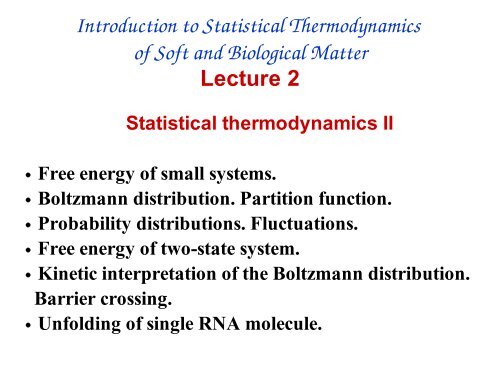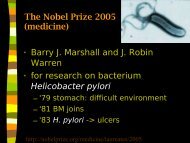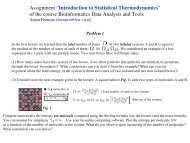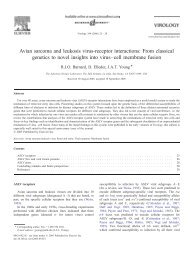Introduction to Statistical Thermodynamics of Soft and Biological ...
Introduction to Statistical Thermodynamics of Soft and Biological ...
Introduction to Statistical Thermodynamics of Soft and Biological ...
Create successful ePaper yourself
Turn your PDF publications into a flip-book with our unique Google optimized e-Paper software.
<strong>Introduction</strong> <strong>to</strong> <strong>Statistical</strong> <strong>Thermodynamics</strong><br />
<strong>of</strong> S<strong>of</strong>t <strong>and</strong> <strong>Biological</strong> Matter<br />
Lecture 2<br />
<strong>Statistical</strong> thermodynamics II<br />
• Free energy <strong>of</strong> small systems.<br />
• Boltzmann distribution. Partition function.<br />
• Probability distributions. Fluctuations.<br />
• Free energy <strong>of</strong> two-state system.<br />
• Kinetic interpretation <strong>of</strong> the Boltzmann distribution.<br />
Barrier crossing.<br />
• Unfolding <strong>of</strong> single RNA molecule.
Some more s<strong>of</strong>t <strong>and</strong> biological matter…<br />
Polymers<br />
Gels<br />
sol<br />
gel<br />
Polymers – linear macromolecules<br />
• Amphiphiles: soaps, lipids, membranes<br />
• polar head (love water)<br />
• hydrocarbon tail (hate water)<br />
Self-assembly
And more biological matter…<br />
Actin in cell<br />
Cell on substrate<br />
bilayer vesicle<br />
Vesicle shapes
Entropy…<br />
Molecules A<br />
Molecules B<br />
Probability <strong>of</strong> each state:
Hard-sphere liquid<br />
Lower Entropy…<br />
Hard-sphere freezing is driven<br />
by entropy !<br />
Higher Entropy…<br />
Hard-sphere crystal
Entropy <strong>of</strong> ideal gas<br />
For one molecule:<br />
V – <strong>to</strong>tal volume<br />
- “cell” volume (quantum uncertainty )<br />
For N molecules:<br />
Indistinguishablility<br />
Free energy <strong>of</strong> ideal gas:<br />
density:
Pressure <strong>of</strong> ideal gas<br />
Free energy <strong>of</strong> ideal gas:<br />
N – number <strong>of</strong> particles<br />
V - volume<br />
density:<br />
Pressure:<br />
Osmotic forces:<br />
Concentration difference induces<br />
osmotic pressure<br />
Semipermeable membrane<br />
(only solvent can penetrate)<br />
Protein solution
Free energy<br />
For closed system:<br />
a<br />
Small system<br />
Reservoir, T<br />
For open (small) system Free energy is minimized:<br />
- Helmholtz free energy<br />
- Gibbs free energy
Protein molecule with several<br />
possible conformations<br />
Free energy l<strong>and</strong>scape:<br />
Free energy<br />
1<br />
2<br />
3<br />
M<br />
Reaction coordinate (order parameter)
Boltzmann distribution<br />
• System with many possible states (M possible states)<br />
(different conformations <strong>of</strong> protein molecule)<br />
Each state has probability<br />
Each state has energy<br />
Free energy (per one protein molecule):<br />
- normalization condition<br />
Constraint minimization<br />
• Minimize free energy with respect <strong>to</strong> :
Constraint minimization<br />
Minimize free energy:<br />
Subject <strong>to</strong> constraint:<br />
Method <strong>of</strong> Lagrange Multipliers (look at any book on calculus):<br />
Lagrange multiplier
Partition function<br />
Free energy:<br />
Minimize free energy. Solution:<br />
Substitute in<strong>to</strong> F:<br />
Partition function:
Sequence Analysis Course…Lecture 9<br />
Boltzmann equation
DNA/Protein structure-function analysis<br />
<strong>and</strong> prediction. Lecture 10…<br />
Self-Consistent Mean Field (SCMF) modeling
The notion <strong>of</strong> probability distribution<br />
• Probability distribution function:<br />
- r<strong>and</strong>om variable<br />
- probability <strong>to</strong> find in the interval<br />
- normalization condition<br />
Fluctuation (variance):<br />
- average value <strong>of</strong>
Examples <strong>of</strong> probability distributions<br />
Gaussian probability distribution:<br />
Your turn: find A<br />
variance:<br />
Uniform probability distribution:<br />
2<br />
1.75<br />
1.5<br />
1.25<br />
1<br />
0.75<br />
0.5<br />
0.25<br />
0.25 0.5 0.75 1 1.25 1.5 1.75 2
Example: fluctuations <strong>of</strong> spring<br />
in thermal bath<br />
- energy <strong>of</strong> spring<br />
verify:<br />
- probability distribution<br />
Equipartition theorem:
Example: Two state system
Kinetic interpretation <strong>of</strong> the<br />
Boltzmann distribution<br />
- activation barrier<br />
Detailed balance (at equilibrium):<br />
Number <strong>of</strong> molecules in state 2 <strong>and</strong> in state 1
Unfolding <strong>of</strong> single RNA molecule<br />
J. Liphardt et al., Science 292, 733 (2001)<br />
Optical tweezers apparatus:
Twostate system <strong>and</strong> unfolding<br />
<strong>of</strong> single RNA molecule<br />
J. Liphardt et al., Science 292, 733 (2001)<br />
Extension<br />
Open state:<br />
Close state (force applied):<br />
force<br />
extension









